The Microsoft Surface Book 3 (15-Inch) Review: A Refreshing Dip Into Ice Lake
by Brett Howse on June 3, 2020 9:00 AM ESTGPU Performance
The original Surface Book shipped with a relatively meager GPU in the keyboard base, but Microsoft added the Performance Base as a mid-cycle refresh which redefined the Surface Book category. You can still opt for the 13.5-inch model without a GPU, or get it with the GeForce GTX 1650 Max-Q. That’s a big upgrade over the outgoing GTX 1050 in the smaller Book. Meanwhile the bigger 15-inch Book 3 upgrades from the outgoing GTX 1060 to the GTX 1660 Ti. The new Turing-based GPUs don’t offer the ray-tracing hardware found on the RTX series, but are both a big step-up from the outgoing models in all other respects.
For the first time ever, Microsoft is also offering a Quadro option as well, with the Quadro RTX 3000. This is an even more powerful GPU than the GTX 1660 Ti, so not only should you see better performance, but you get NVIDIA's RT cores as well. From a hardware perspective the Quadro RTX 3000 is functionally equivalent to the GeForce RTX 2060, with 1920 CUDA Cores, so it is a bit of a surprise that Microsoft didn't make a GeForce RTX 2060 an option. That said, on paper the Quadro RTX 3000 is perhaps a bit too powerful for a device like the Surface Book 3 – it's almost certainly running at the lower-end of its TDP range to fit in here – which is a hint that there's more going on. NVIDIA's notebook GPU stack is notably inconsistent between the GeForce and Quadro families, and the company doesn't have a true Quadro equivalent of the GTX 1660 Ti. so from a TDP standpoint, the Quadro RTX 3000 is the next closest thing available.
To see how the new Surface Book 3 fares in GPU tests, we’ve run it through our gaming workloads. We’d love to add some more productivity tests that can leverage the GPU as well, so if you have any feedback please reach out.
As with the CPU tests, most of the notebooks the Surface Book 3 will be compared against will be Ultrabooks with no GPU. Unfortunately, we’ve not had any mid-range gaming laptops recently to see where the GPU stacks up. You can of course compare these results against any other system we have tested using our Online Bench.
We’ll start with some synthetics and then move on to gaming workloads.
3DMark
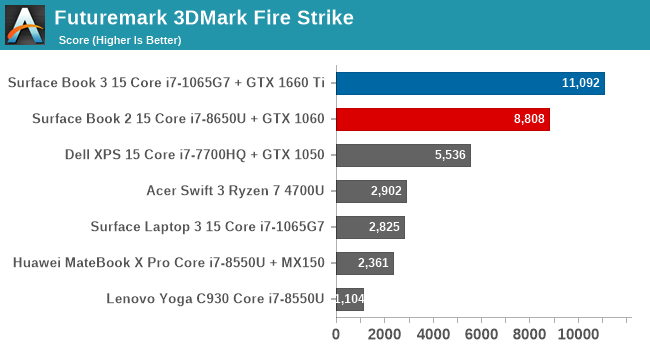
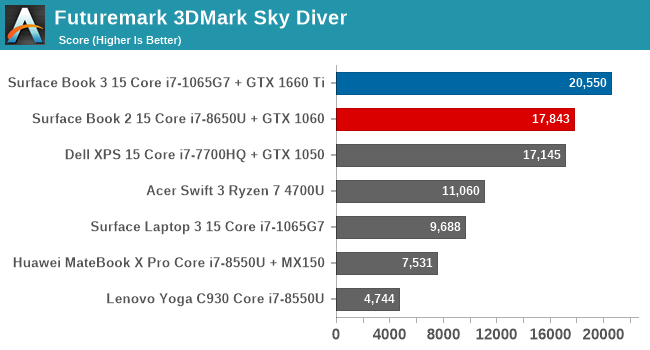
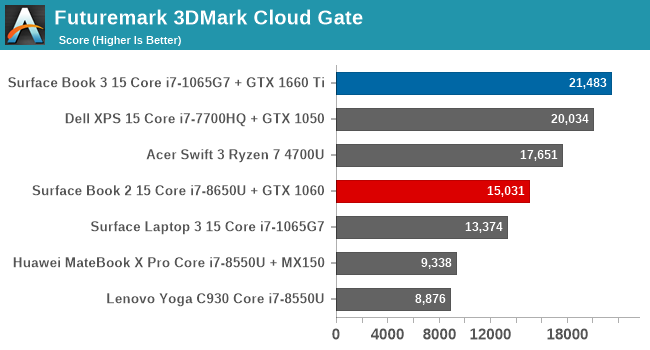
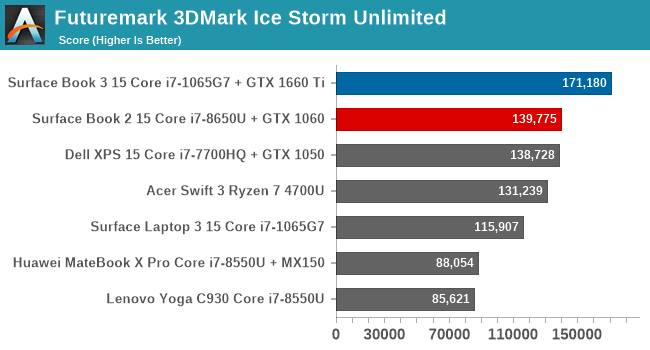

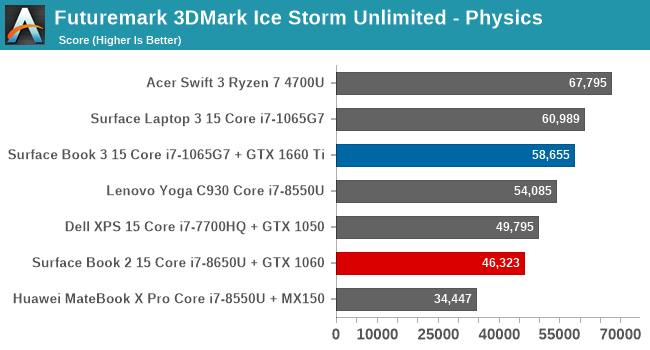
UL’s 3DMark tests a couple of different scenarios, from the very complex Fire Strike down to Ice Storm Unlimited which can be run on smartphones. As the scenes get less complex, the CPU becomes more of a bottleneck. The new CPU and GPU offer a significant increase in performance over the outgoing model.
GFXBench
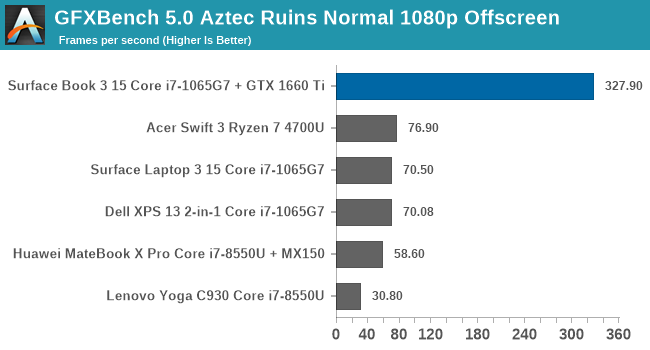
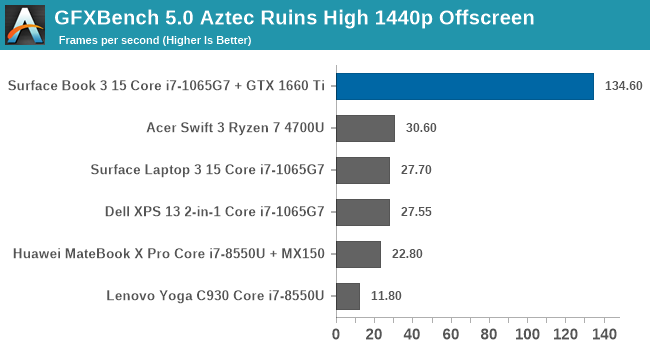
Kishonti’s GFXBench started offering DirectX 12 rendered tests with version 5.0 and instantly made it relevant again. The GTX 1660 Ti handles these tests with aplomb.
Tomb Raider

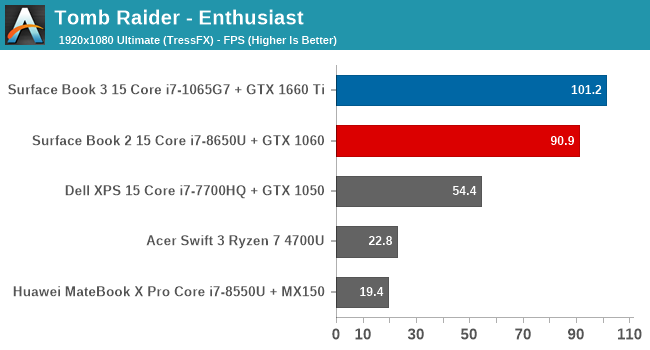
The original Tomb Raider game can be a challenge for devices with integrated GPUs, although the latest AMD Vega and Intel Iris Plus integrated GPUs have come a long way. On Value settings, the old Surface Book 2 was actually slightly ahead, but the Enthusiast level puts things back in the right order.
Rise of the Tomb Raider


The Tomb Raider sequel added DirectX 12 support and added a lot more visual fidelity, and as such the game is much more demanding. The new Surface Book 3 shows a big jump here.
Shadow of the Tomb Raider


The latest in the franchise is even more demanding. Interestingly the benchmark also shows how often the scene was GPU bound. On the Value settings, it was GPU bound only 8% of the time (and therefore 92% of the time it was CPU bound) but once the settings were turned up to 1920x1080 Highest plus TAA, the Surface Book 3 was GPU bound 93% of the test run.
Civilization VI
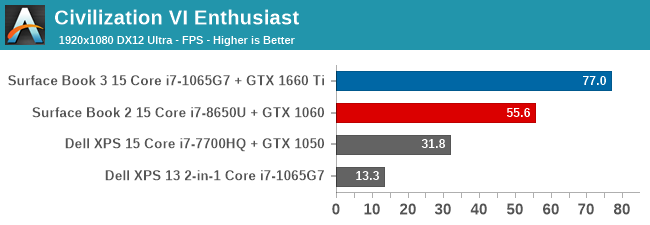
Once again, the Surface Book 3 shows a significant jump over the outgoing model.
Far Cry 5


Far Cry 5 is at the limits of what integrated GPUs can achieve right now, but the Surface Book 3 handles this game very well.
F1 2019


Codemasters’ F1 2019 is also playable on integrated graphics, but much more playable on the Surface Book 3.
GPU Conclusion
The NVIDIA GTX 1660 Ti, even in the Max-Q configuration as in this notebook, offers far more performance than the outgoing GTX 1060. The Surface Book 3 is not a “gaming laptop” by any means, but it certainly has the required chops to be used for gaming when needed. The integrated Xbox wireless for connecting a controller is also a perk, and a perk only found on the 15-inch version. The only downside is that the Surface Book’s 3:2 display can be a problem if the game is expecting 16:9, so your mileage may vary.
If you have a GPU-based productivity task though, the Surface Book 3 offers far more performance than other similar devices. The GTX 1660 Ti offers 50% more CUDA Cores than a GTX 1650 Ti. The Surface Book is somewhat compromised on CPU due to the CPU having to be behind the display, but the extra thermal capacity available by separating the heat loads sure lets them stuff a big GPU in the base.


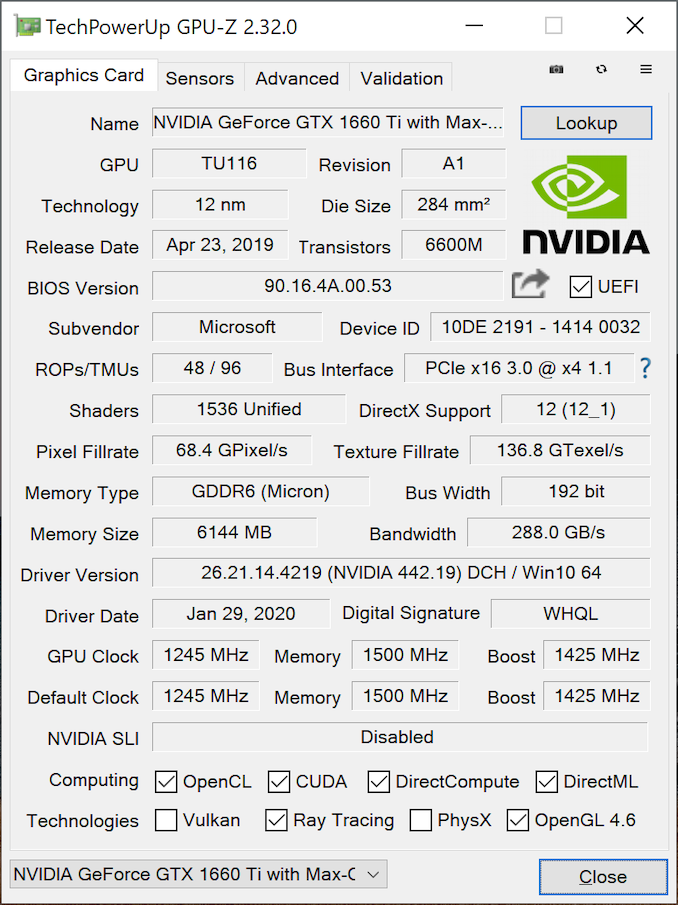








125 Comments
View All Comments
zepi - Thursday, June 4, 2020 - link
How was batterylife in tablet mode without the base?Brett Howse - Friday, June 5, 2020 - link
Sorry I had tested that but forgot to add it to the graphs. It's there now.Wrong_again - Thursday, June 4, 2020 - link
It seems like an unpopular opinion but tablet devices should not have tiny bezels. For reasons that seem obvious to me.Retycint - Thursday, June 4, 2020 - link
The iPad Pro manages to have smaller bezels while not significantly affecting the usability. Smaller bezels does not necessarily mean tiny bezelss.yu - Thursday, June 4, 2020 - link
There's clearly a gap between this and "tiny". Also, again, the XPS 13 2N1 has a perfectly functional screen with arguably "tiny" bezels.PeachNCream - Thursday, June 4, 2020 - link
Tablets aren't really even a thing anymore. Hardly any company makes a credible attempt at producing one outside of the usual iFruits and Microsoft (I guess Google has Chrome-based hardware too if you like giving your personal information to the creepiest company on the planet). There are still a few 2-in-1 systems around and ultra low budget Android devices, plus a couple of laptops with questionably glossy touchscreens for reasons only the OEM can fully understand, but in general terms, tablets - Windows ones moreso than others - have been taken out back and shot, then tossed into a shallow grave with a bunch of other tech fads that failed to take enduring root.It is unexpected to watch Microsoft continue to release new models in a form factor that is laying in the desert, gasping its last parched air before failing to pull a Clint Eastwood-style survival montage. They already transitioned partly to clamshell designs to hedge the Surface brand name. It really is odd to see them clinging to the touch-everywhere bad old days of Windows 8.
lazybum131 - Thursday, June 4, 2020 - link
"It really is odd to see them clinging to the touch-everywhere bad old days of Windows 8."If only Microsoft actually did, then the tablet experience with Win 10 wouldn't be so poor. On Windows pure and detachable tablets aren't strong because the tablet experience just isn't good or polished even for built-in basic functions, let alone the barren app Store. Add in the slow progress on low-tdp chips that would actually enable portable designs.
lmcd - Thursday, June 4, 2020 - link
Intel's Lakefield could change the story there -- aside from the Intel tax with the experimental-technology surcharge, it could fit in 8 inch tablets. Based on the Surface Neo delay, I'd assume it's using a Lakefield chip.Microsoft's lack of good tablet software in the store boils down to the .NET team absolutely ignoring everything the Windows team would prioritize. Windows 10X doubles down on UWP while the .NET team hasn't released an up-to-date AOT compiler and C# project format in over 2 years.
Deicidium369 - Friday, June 5, 2020 - link
I will probably use the tablet mode on the 13 2-in-1 about as much as on the previous model - not much at all - but when needed (stocking up at a Spec's type place for a party) it is very useful. But yeah the time of the tablets looks to be over.Deicidium369 - Friday, June 5, 2020 - link
would be obvious 1st time it got dropped...